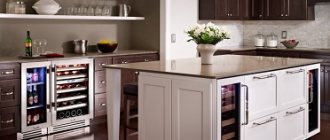A refrigerator is one of the most important and necessary purchases in any household. At the same time, modern manufacturers offer a huge number of models and options for such a useful kitchen device - from tiny refrigerators, which will only include a few fresh fruits, cheese and a bottle of wine, to wonderful and convenient Side by Side appliances - two-door hinged beauties that can decorate any room. kitchen.
However, before purchasing the model you like, you should definitely decide whether the unit you like will fit into the existing room and how well it will fit into the space. Let's look at the basic requirements for the location of the refrigerator and where it is better to place such an important device if there are several places for its installation.
Basic rules for placing a refrigerator in the kitchen
In fact, there are not so many rules for installing a refrigerator, but following them will extend the life of the device and reduce the likelihood of its breakdown. At the same time, please note that our article will focus exclusively on free-standing refrigerators - they are subject to fairly strict requirements regarding placement.
There are practically no requirements for built-in models, since such devices initially require installation in a specialized cabinet, which will simultaneously perform both a decorative and protective function.
So, what is the popular device designed to keep food cool and fresh “afraid of”?
Proximity to heat sources
Alas, the principle of operation of the refrigerator involves the creation of cold temperatures inside the device due to (including) some heating of the surrounding air outside. Accordingly, placing the refrigerator in close proximity to the radiator or stove will not only prevent the high-quality dispersion of hot air, but will also create additional heating of the outer walls of the device, which will clearly not benefit its long-term and reliable operation.
Important! No matter how small the kitchen space is, try to place cabinets, tables or other pieces of furniture at least 20-30 cm wide between the refrigerator and such serious heat sources as a stove or radiator - this will significantly increase the life of kitchen appliances.
Tight fit
No pieces of furniture should be pressed too tightly against the refrigerator. The minimum permissible gap on the side walls of the device is 2–3 cm. The same requirement applies to the proximity of the device to a wall or window. In this case, you should maintain a decent distance between the back wall of the refrigerator and the kitchen wall. So, for modern models the minimum size of free space “at the back” is the same 2–3 cm, and for refrigerators with a radiator - 10 cm or more. This is also required for high-quality heat removal from the operating device.
Sun rays
As a rule, the front surface and doors of the refrigerator are well insulated, so exposure to direct sunlight for any, even long, period of time will not damage the appliance. The same cannot be said about the side walls of the device, where such insulation is usually not used, and solar heating is quite capable of causing malfunctions and rapid breakdown of the unit.
Therefore, if you plan to place the refrigerator in such a way that its side walls will be exposed to sunlight, you should take care of their additional protection.
Important! If you plan to place the refrigerator near a window, then the required gap between the wall of the appliance and the wall of the room should be 10 cm or more. This will not only prevent overheating of the refrigerator, but will also make it possible to open its door completely by 90 degrees or more. At the same time, kitchen curtains and drapes can be moved into the resulting gap between the wall and the appliance without creasing them, which will make the kitchen more cozy and comfortable.
Water
Many housewives prefer to place the refrigerator in close proximity to the sink, explaining this by ease of use: after all, meat or vegetables removed from the refrigerator can be immediately placed in the sink, without carrying them halfway across the kitchen.
Nevertheless, such a proximity also does not have a very favorable effect on the operation of the refrigeration chamber. Apart from the fact that electrical appliances, in principle, do not particularly like being near water, high humidity and splashes, which invariably occur when washing dishes, will quickly give the refrigerator an unsightly appearance and significantly reduce its operating potential. Therefore, it is worth remembering that the minimum recommended distance between the refrigerator and the sink should be 30 cm or more.
Other premises
In principle, placing a refrigerator in a room, corridor or even on an insulated loggia is not prohibited, provided that the requirements for ambient temperature and humidity specified in the instructions for the device are met. But still, installing a refrigerator away from the kitchen is recommended only if it is completely impossible to place it directly inside the room intended for cooking.
Important! As a rule, refrigerators presented on the Russian market operate fully at ambient temperatures from -5 to +30 °C. At lower temperatures, the refrigerator will simply fail and is unlikely to be repairable. But if the air temperature exceeds the maximum values for a long time, then it is worth considering “tropical” models of refrigerators, originally intended for use in very hot climates, which are not so widely represented on the Russian market, but are nevertheless found in the lines of manufacturers intended for southern regions. warm regions.
Freedom of access
One of the main rules is free access to the refrigerator and the ability to fully open the door. And this is precisely the rule that should not be neglected. Whatever the size of the kitchen, the number of steps between the refrigerator, table and work surface should not exceed 3-5, otherwise each trip to buy fresh food and back will be accompanied by slowly growing dissatisfaction from the non-ergonomic placement of the appliance.
And no matter how much you would like to gain at least another 5–10 cm of space, the refrigerator door must still open to the required 90 degrees or more, that is, the distance between the side wall of the refrigerator and the wall should allow its door to be fully opened.
Cooling system
Most often in such refrigerators there is a “No Frost” cooling system, which involves the presence of one compressor. This is good, because this reduces the price of the unit. For example, Samsung equips its refrigerators only with a dry cooling system, explaining this by greater efficiency, because air circulation occurs constantly. An undeniable advantage of the “No Frost” system is that there is no need to defrost the chamber. Condensation accumulates in special compartments and evaporates. Dry freezing allows you to freeze semi-finished products faster without sticking.
Economical consumption of electricity is relevant in the modern world. Double-door refrigerators are a new invention, and therefore require a high energy consumption class, usually not lower than A+.
Double-door refrigerator built into cabinet furniture
Double Door Refrigerator with Ice Maker Miele Double Door Refrigerator
If the kitchen is large
A large kitchen is the dream of any housewife, because its large size allows you to realize all your kitchen ideas and use the maximum number of stylish and useful kitchen items.
Placing a refrigerator in a large kitchen has virtually no barriers, because it can be installed:
traditionally - in one of the corners, in which there are no radiators - such placement is not only familiar and convenient, but also meets the requirements for the ergonomics of the room, the convenience of being in it and even the instructions of Feng Shui, since it visually makes the kitchen “softer” and “rounder” ;
centralized - the design idea is quite capable of making this device the center of the entire kitchen, especially if the refrigerator itself has significant dimensions and rich functionality, such as, for example, a TV screen built into the front panel or buttons and compartments placed on the doors for serving drinks from the cooling chambers; in this case, the rest of the kitchen set is built around this device and matched to its “style”;
individually - if the room allows, then the refrigerator should be allocated its own individual part of the territory, not in contact with other kitchen appliances or kitchen furniture; at the same time, you can create a stylish and interesting design of wallpaper or wall coverings, against which the refrigeration unit will be placed.
Location options
You can place the refrigerator in any convenient place. The main thing is to prevent it from coming into contact with heating devices and water.
Under the oven
Here again, you should not install a refrigerator due to the high degree of heating during operation of the oven.
In the closet
If space allows, the refrigerator can be placed in a closet. Especially if it is a built-in refrigerator.
In the corner
This is perhaps the most common place where a refrigerator is placed. In the corner it eats up minimal kitchen space.
On the island
The refrigerator can also be placed in an island, the main thing is to follow the rule of the golden triangle.
Behind the buffet doors
This is the ideal place for a built-in refrigerator.
If the kitchen is small
Unfortunately, most Russian kitchens are of such dimensions that do not allow much design thought to be developed. In “Khrushchev”, “Brezhnev” and even in apartments “with improved layouts” the size of the kitchen usually does not exceed 5–8 square meters. m, which significantly reduces the number of options for placing kitchen appliances.
Where to install the refrigerator if the kitchen has exactly this area?
Let's look at the most popular options:
at the entrance - more than half of the owners of small kitchens choose this particular placement of the cooling unit, which allows the device to successfully fit into the working triangle “refrigerator - sink - stove” and easily attach a standard corner kitchen unit to it;
by the window - the second most common option, more typical for slightly larger kitchens, in which the distance between the window and the gas pipe or socket for the electric stove is more than 60–80 cm, sufficient to place a standard refrigerator there; in this case, you should still remember that it is inadmissible to be close to the stove - you should place at least a 30-centimeter cabinet between these devices;
outside the kitchen is also a frequently encountered principle of placing a refrigerator, which, as a rule, causes the greatest number of complaints from its owners, because the device makes noise, hums, sometimes turns on abruptly and makes strange sounds, especially frightening and unpleasant at night, and the indicators that Many modern devices are equipped, which also do little to contribute to a comfortable stay in sufficient proximity to the refrigerator;
in niches, pantries, cabinets, including those formed as a result of redevelopment - this is perhaps the most successful location of the refrigerator, which has only one rather big drawback - often such niches and cabinets have rather non-standard sizes, which greatly limits the choice of device model;
in work cabinets, at the bottom of the dining table - not the most popular way to place a refrigerator, which also requires certain dimensions of the device, however, when selecting a suitable model or purchasing a separate small refrigerator and a separate freezer, this method of placement can be considered almost ideal - after all, it is a necessary and useful unit , built into a set or under a window sill, does not take up a single centimeter of such necessary and important kitchen space.
We can also advise owners of small kitchens:
- First of all, consider compact models of refrigerators with a width of 40–50 cm and a height of 140–160 cm, which will allow better use of every centimeter of a small kitchen;
- give preference to built-in models of refrigerators, which will visually look like part of a kitchen unit and will allow you to wisely use the space above the appliance (and for some models, under it) for storing kitchen utensils and other accessories;
- do not clutter the kitchen with too large and multifunctional devices, since it is very uncomfortable to dine, and just be in a room where it is difficult to fit even two people.
Of course, a refrigerator is one of the most popular kitchen appliances, and therefore I want to choose an option that will be as functional as possible and at the same time will not make too big a hole in the family budget. However, when choosing a model, you should not forget that the main requirement is ease of use and the absence of discomfort associated with a device that is too bulky or poorly placed.
Think about it, perhaps you should still give preference to compact and small appliances: after all, in this case, such healthy fresh products will appear on your table more often, and being in an uncluttered kitchen will allow you to get true pleasure and satisfaction from sharing lunches and dinners with your beloved household members and pleasant people. interlocutors.
Built-in two-door assistant
If we are talking about a built-in refrigerator, then it is assumed that the unit will be located in a special niche. The facade will be hidden from view by doors made in the same style as the entire kitchen unit.
Two-door refrigerator in Art Nouveau style
Owners of houses and apartments, for whom every detail in the interior is important, as a rule, choose this type of refrigerator. It is difficult to imagine how the modern doors of an ordinary refrigerator will fit into the Provence style. Therefore, built-in appliances are an excellent option for many interior styles. Moreover, if such a cabinet is planned to be located in an office or hallway.
Double door refrigerator with water compartment
Real photo examples of placing a refrigerator in the kitchen
What to look for when choosing?
A large refrigeration unit has its own characteristics that every savvy buyer needs to take into account before making an important purchase.
- The heat exchanger is located at the bottom of the unit, so it is strongly recommended not to install it on floors with any type of heating. Otherwise, the service life of the refrigerator will be reduced significantly.
- You should take measurements of the doorways in your home, because the refrigerator is of non-standard dimensions, and it may simply not be carried to its destination. However, removable unit doors can solve this problem.
- “Side by side” can have two no frost systems or a combined one.
If additional functions include ice making, then you need to consider the possibility of connecting the equipment to the water supply.
Siemens double door refrigerator
Double Door Refrigerator with Temperature Control
Advantages and disadvantages of built-in technology
Refrigerators built into kitchen furniture are an ideal choice for people whose kitchens are decorated in a classic style. In the last few years, the popularity of such equipment has begun to grow rapidly and therefore manufacturers have begun to produce more such devices.
Built-in technology has a number of advantages and disadvantages. Among the advantages are the following:
- Silence. Such devices operate very quietly, since furniture walls are adjacent to their body, which completely dampen all noise.
- Ergonomics. Using built-in appliances, people can keep all the food they need at hand.
- Easy to care for. Caring for built-in refrigerators is quite simple, since their side walls are hidden and rarely get dirty.
- Reducing electricity consumption. Companies involved in the production of equipment built into a cabinet or niche take care of its thermal insulation. Many models have a special protective layer that reduces the heating of refrigerators and prevents them from consuming a lot of electricity.
- Variety of model range. Today, a huge number of built-in refrigerators are produced, which differ from each other not only in appearance, but also in placement features.
Despite the huge number of advantages, built-in appliances have several disadvantages. These include the following:
- Fewer cameras. Built-in refrigerators are most often quite small when compared to classic models. Some of them may not even have a freezer.
- High price. Such equipment can cost several times more than conventional models.
- Difficult to install. Installing built-in devices is not easy and therefore not everyone can do it.
A variety of models is one of the advantages of built-in technology
Neoclassical style
and kitchen design
Neoclassical kitchens are no different in functionality from modern models. They differ only in facades. In neoclassical kitchens you can often find paneled facades. In such options, there are almost always ordinary handles.
If the facades are smooth and without handles, then they will be identical to modern kitchens.
Neoclassical kitchen is here!
Model rating
There are several models that fit perfectly into furniture:
- Atlant 4307. This is a compact model that is built into a headset. Among the advantages of Atlant 4307 are its low cost, build quality and compactness.
- Liebherr 6613. The Liebherr company produces high-quality refrigerators. The Liebherr 6613 model is equipped with a freezer and a special compartment for storing food.
- Bosch Kiv38×20. A fairly large built-in refrigerator, which is equipped with a spacious freezer. The advantages of this model include its noiselessness during operation, affordable cost and fast freezing.
Liebherr 6613 is one of the highest quality built-in refrigerators
How are they different from regular ones?
Many people who are planning to purchase and install a built-in refrigerator are interested in how it differs from classic non-built-in models. There are several characteristic differences between these models:
- Differences in the ventilation system. Built-in models are equipped with a thoughtful and high-quality ventilation system. Conventional refrigerators do not have this.
- Poor structural stability. Conventional refrigerator models are less stable, unlike built-in ones.
- Reducing free space. Devices that are not built into a cabinet or set take up a lot of free space. Therefore, they are not very suitable for a Khrushchev or a small studio apartment.
Installation Requirements
A built-in vertical or horizontal refrigerator for the kitchen is installed in a special cabinet. At the same time, it must be installed in such a way that air circulates freely inside the pencil case. This can only be achieved by adhering to the following recommendations:
- Between the walls of the cabinet and the equipment you need to leave gaps of about 3-5 centimeters. Therefore, a special seal is often placed on the side walls of devices.
- There should be an opening in the back behind the cabinet in which the refrigerator is located. The distance from the wall to the cabinet is no less than 150 millimeters.
- The distance to the wall should not be too large. It should be such that a person can reach the top drawers or microwave with his hand.
How to install a non-built-in refrigerator in a closet
If necessary, a simple refrigerator can be built into the cabinets. This is done in several successive stages:
- Scheme design. First you need to develop a layout for placing equipment in the closet. In this case, you need to take into account the dimensions of the refrigerator and the cabinet in which it will be installed.
- Preparing the cabinet. After taking measurements and working out the diagram, you can begin preparing the cabinet. It must be disassembled, after which all parts are adjusted to the required dimensions. The cabinet can then be assembled.
- Installation of equipment. After the cabinet has been assembled, installation of equipment begins. Before installation, all handles and legs must be removed from the device so that they do not interfere.
Compressor type
Modern manufacturers offer two-door refrigerators only with an inverter compressor. Thanks to this, there are no sharp temperature fluctuations in the chambers, the noise produced by the mechanism is minimal, and energy consumption is economical. As a rule, such compressors have a long service life. Manufacturers provide a guarantee of at least 10 years. There is one disadvantage of inverter compressors: they are sensitive to changes in network voltage. Serious manufacturers definitely take care of special protection for such refrigerators.
Double door refrigerator with wine compartment











